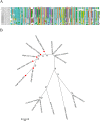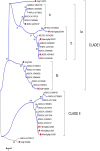Deep Sequencing Analysis of the Ixodes ricinus Haemocytome
- PMID: 25970599
- PMCID: PMC4430169
- DOI: 10.1371/journal.pntd.0003754
Deep Sequencing Analysis of the Ixodes ricinus Haemocytome
Erratum in
-
Correction: Deep Sequencing Analysis of the Ixodes ricinus Haemocytome.PLoS Negl Trop Dis. 2015 Jul 17;9(7):e0003909. doi: 10.1371/journal.pntd.0003909. eCollection 2015 Jul. PLoS Negl Trop Dis. 2015. PMID: 26186647 Free PMC article. No abstract available.
Abstract
Background: Ixodes ricinus is the main tick vector of the microbes that cause Lyme disease and tick-borne encephalitis in Europe. Pathogens transmitted by ticks have to overcome innate immunity barriers present in tick tissues, including midgut, salivary glands epithelia and the hemocoel. Molecularly, invertebrate immunity is initiated when pathogen recognition molecules trigger serum or cellular signalling cascades leading to the production of antimicrobials, pathogen opsonization and phagocytosis. We presently aimed at identifying hemocyte transcripts from semi-engorged female I. ricinus ticks by mass sequencing a hemocyte cDNA library and annotating immune-related transcripts based on their hemocyte abundance as well as their ubiquitous distribution.
Methodology/principal findings: De novo assembly of 926,596 pyrosequence reads plus 49,328,982 Illumina reads (148 nt length) from a hemocyte library, together with over 189 million Illumina reads from salivary gland and midgut libraries, generated 15,716 extracted coding sequences (CDS); these are displayed in an annotated hyperlinked spreadsheet format. Read mapping allowed the identification and annotation of tissue-enriched transcripts. A total of 327 transcripts were found significantly over expressed in the hemocyte libraries, including those coding for scavenger receptors, antimicrobial peptides, pathogen recognition proteins, proteases and protease inhibitors. Vitellogenin and lipid metabolism transcription enrichment suggests fat body components. We additionally annotated ubiquitously distributed transcripts associated with immune function, including immune-associated signal transduction proteins and transcription factors, including the STAT transcription factor.
Conclusions/significance: This is the first systems biology approach to describe the genes expressed in the haemocytes of this neglected disease vector. A total of 2,860 coding sequences were deposited to GenBank, increasing to 27,547 the number so far deposited by our previous transcriptome studies that serves as a discovery platform for studies with I. ricinus biochemistry and physiology.
Conflict of interest statement
The authors have declared that no competing interests exist.
Figures







References
-
- de la Fuente J, Estrada-Pena A, Venzal JM, Kocan KM, Sonenshine DE. Overview: Ticks as vectors of pathogens that cause disease in humans and animals. Front Biosci. 2008;13:6938–46. - PubMed
-
- Kopacek P, Hajdusek O, Buresova V, Daffre S. Tick innate immunity. Adv Exp Med Biol. 2010;708:137–62. - PubMed
-
- Valenzuela JG, Francischetti IM, Pham VM, Garfield MK, Mather TN, Ribeiro JM. Exploring the sialome of the tick Ixodes scapularis . J Exp Biol. 2002;205(Pt 18):2843–64. - PubMed
-
- Santos IK, Valenzuela JG, Ribeiro JM, de Castro M, Costa JN, Costa AM, et al. Gene discovery in Boophilus microplus, the cattle tick: the transcriptomes of ovaries, salivary glands, and hemocytes. Ann N Y Acad Sci. 2004;1026:242–6. - PubMed
Publication types
MeSH terms
Substances
Associated data
Grants and funding
LinkOut - more resources
Full Text Sources
Other Literature Sources
Research Materials

